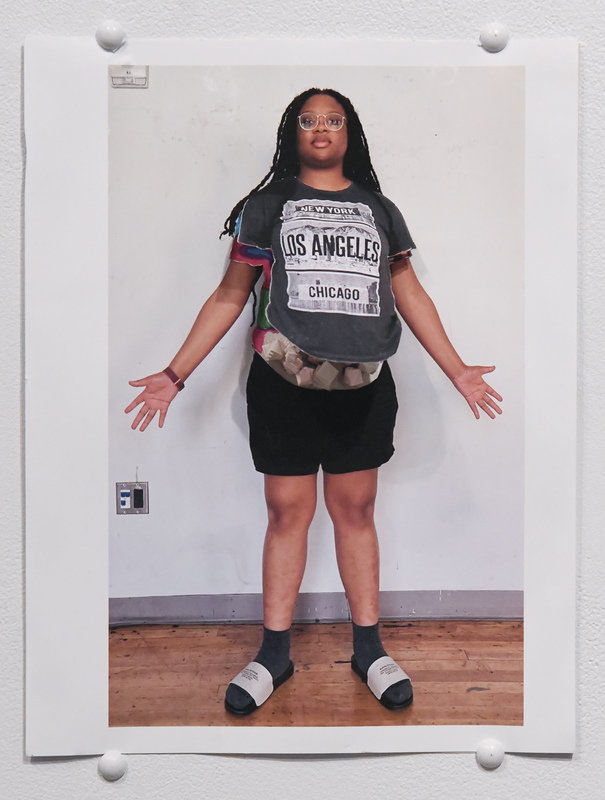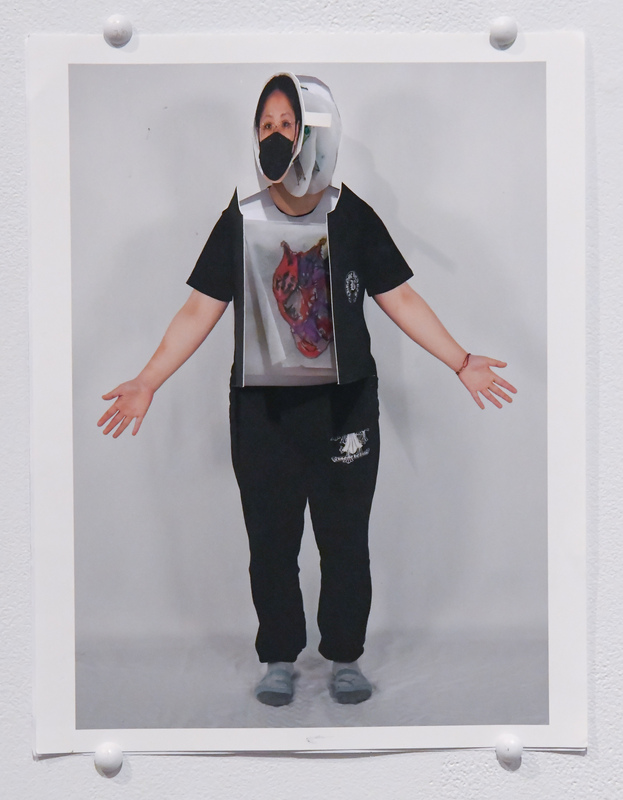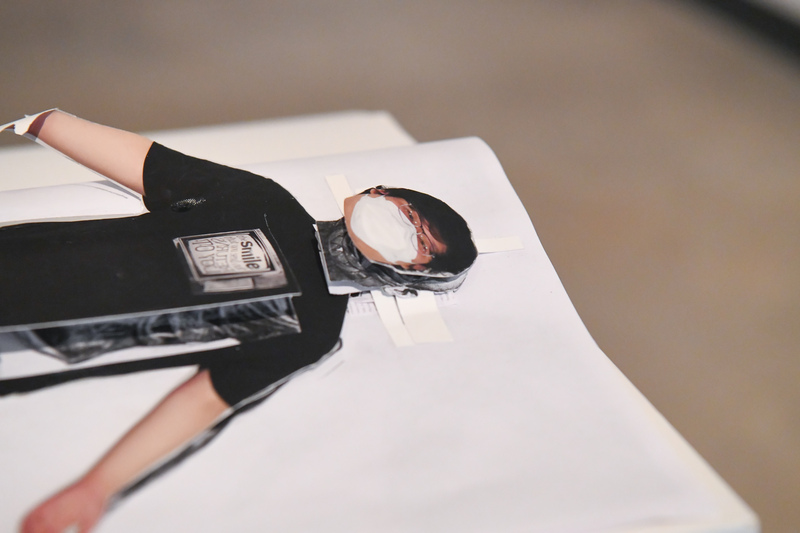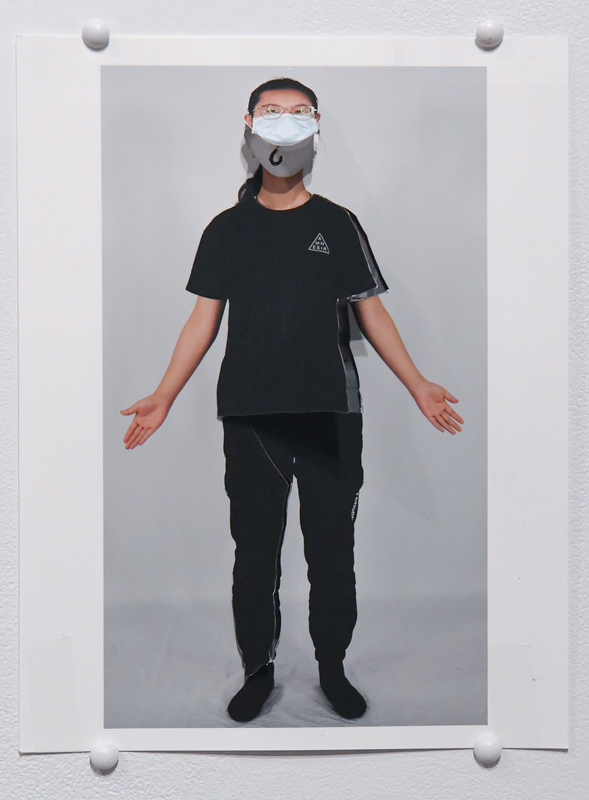Artist Statements
Cleah Fast
Lift Your Gaze
Acrylic and ink on paper, print on metal, cords, computer keys.
Lift Your Gaze, is a modern adaptation of early 15th century anatomical flap broadsheets, here focused on the brain, vocal cords, and jaw. In making this work, I reflected on my amazement that the brain is the circuit board of the body yet is small enough to hold in your own two hands. The optic nerve that connects the eyes to the brain is fascinating in the sense that the eye is the outward visible manifestation of the brain – a connection which, if not cared for, can create impaired and damaged vision. When this connection is so fragile it poses the question of why we physically expose our brains to sources that can alter its function?
The ocularcentric digital age, otherwise known as the 21st century, has made it impossible to avoid the use of technology in our everyday lives, yet there are dangers embedded in this use. Technology is so interwoven into our daily lives that we, as a society, have become obsessed with screen time. This obsession provides fertile ground from which addictions can grow at a very young age, threatening the experiences of a typical childhood. When an eight-year-old is proficient in navigating their iPhones but seems to have lost the notion of what play is, or even how to play, there is a monumental social disconnect. Technology has altered the way we communicate, stripping us of the need for face-to-face interaction. Instead, we ‘speak’ to one another by typing on a keyboard while failing to be in the physical presence of each other. Without thoughtfully identifying the dangers that technology can bring, we see how our fascination with the virtual world separates us from reality.
A further point of reflection that inspired this piece is the desensitization of the physical body through our engagement with technology. Hiding behind our devices allow us to be aware of what is happening in the world yet stay far enough away to have a physical disconnect. When viewing and interacting with historical anatomical books and illustrations it becomes easy to ignore the fact that these representations were based on real human beings put on display—people who had lives and loved ones. In some cases, peoples’ lives were sacrificed for the advancement of science and medicine, in turn allowing for a greater understanding of our anatomy. This advancement in knowledge and understanding is another social disconnect with regards to how certain groups of people were ‘seen’ and as a result were devalued.
As you share time with this piece, I ask you to consider how technology is part of your life. How does technology impact your life for better or worse? What are you willing to miss out on? Can you lift your gaze?
David Figueroa
Wild at Heart
Graphite, pressed flowers, and stickers on paper (2022)
Within the history of anatomical artwork, the human figure representing ‘man’ as God’s divine creation is commonly placed within an idyllic landscape. This denotes human’s connection to, and dominion over, the natural world. The figure’s anatomical layers would be revealed until the skeleton was exposed—a corporeality symbolizing human’s temporal journey toward death. This deterioration of material decay is mirrored in the landscape’s incremental progression of the seasons.
Forming a relationship with the historic anatomical artworks, the reference image for ‘Wild at Heart’ is taken from Andreas Vesalius’ series of seven books, De humani corporis fabrica libri septem, which were highly influential toward the study of human anatomy. This particular image, chosen for its classical pose of the figure, resonated with me, presenting a dramatic stance that evoked emotionality within the deceased figure. In my appropriation of Vesalius’ illustration, I purposefully selected graphite as a medium to portray a close facsimile of the original engraving.
In creating my artistic interpretation, I chose to further explore this connection to nature by adding flowers, a dog, and a butterfly. Despite the grotesque realism of the body itself, the form exists in a surrealistic celestial realm. The artwork is titled, ‘Wild at Heart’, to highlight humans’ connection to nature, and how we have evolved from a species from the natural world.
Historically, when anatomical figures were illustrated within an operation theatre rather than a landscape, the figure was often accompanied by a domesticated animal at its feet. This inclusion of an animated dog in my work, about to pounce, symbolizes both nature as well as human’s desire to conquer it. Portrayed as aggressive, as if about to bite, and wearing a broken rope collar, the dog symbolizes the brutality of nature and its inability to be truly harnessed.
The background is appropriated from the original Vesalius’ image—depicting a village with rolling hills visible in the distance—where the looseness of the gestural line work represents the lushness of spring. This approach is continued in the foreground surrounding the figure, where foliage frames the image, representing life, and is juxtaposed against the decaying form.
Similarly, against the monochrome illustration, I have placed colorful wildflowers on the surface to suggest rebirth through the contrast of the life cycle: the figure is at the precipice of death, while the flowers are in bloom. This abundance of wildflowers across the piece becomes a memento mori—a Latin phrase meaning ‘remember you will die’. Used as a gesture of sympathy and symbolizing mourning, these hand-picked flowers will slowly decay within the gallery, acting as a live entity facing death. The addition of skulls in the foreground, depicting the remnants of our decay, mirrors this contrast.
Alyssa Hines
You Don't Have to Say Thank You
Print on cardstock, paper, vinyl LP (2022)
It could be said that it is a universal experience for an artist to wish to create and emulate something that uniquely expresses who they are in that moment or throughout the process: to translate a sense of themself into the world through their work. With the release of her most recent album, Florence Welsh wrote a song that begins: “I was always able to write my way out, song always made sense to me, now I find that when I look down, every page is empty, there is nothing to describe, except the moon still bright against the worrying sky, I pray the trees will get their leaves soon”. These lyrics summarize the gift of being able to see and ingest the world around us and how that is often coupled with the tension and yearning to communicate that back out to the world through our own voice and lens. As a visual artist, I have found it is music that has played the most relentless role in the reflection and creation of my works. Repurposing a vinyl record was the perfect method to capture and convey the powerful influence of song combined with my interest in multi-directional meanings into a visual representation of myself as inspired by the layered anatomical depictions by artists such as Vandelaar, Remellin, and Hollick.
Much in the same way that Vesalius and his depictions of the human body were used and reprinted, with little modification to this original design for many, many years, music possesses the same ability to become timeless, by setting a standard and inspiring the successors of the craft. In his series, De humani corporis fabrica libri septem, Vesalius portrays the many stages of death and decay of his subject, similarly to the images of the table in my work, You Don’t Have to Say Thank You, are depicted in sequential stages of burning. However, instead of death and decay, the songs featured represent themes of discovery, deconstruction, and becoming.
The artists responsible for some of the most studied anatomy flaps made use of many different bodies across varying periods of time in order to showcase ideal depictions of the human form and all its anatomical layers. It is this understanding that sparked the reflection as to how people are made up of many different versions of themselves throughout their lives, flavoured by the influences of those around them. While one version dissolves into another, each with their own significance, another version and further depth is revealed—just as the flesh of each body studied and drawn represented another layer of what the human body is made of. In the same tone, each song and image chosen for this work represent another layer of myself, overtime, as though all different versions of who I have been, were examined and captured as they morphed into the most bare-boned, authentic version—the one I am today.
Glory Inegbedion
Egehiokin's 'Game of Life'
Animations (2022)
There is always a story behind every picture, that is something I learned throughout the duration of the VISA 3V91 course. The course has added a new layer to the way I look at illustrations of the human body, especially the historical ones. Before taking VISA 3V91, my thought process when it came to historical illustrations of the human body was pretty straightforward. I would just think about how talented the person was and how difficult and time tasking it must have been to create such images in print. I have noticed that in recent times when I look at an anatomical photograph or drawing, I tend to think more about the body. I mentally ask myself, where did the body come from? Who was it? What could their socio-economic status have been? Was the body even acquired ethically? Knowing what I know now I believe it is important to acknowledge the basis on which medicine and anatomical drawings are built. Reflecting on the foundation of anatomical illustrations helps us to be thoughtful when representing the human body.
While working on my projects, I thought a lot about how I would like to represent a body…my body. I thought about the flaps like some sort of a self-portrait or a visual biography of myself. For the final project, I wanted to make a piece that will make the viewer reflect on the concept of life and how we value it. The process of coming up with my final project was rather long and complicated. I had gone through several ideas before settling on Egehiokin’s Game of Life. The project is inspired by John H. Conway’s 1970s theory on the game of life. Essentially, his theory states that for a cell to live, at least two of its neighbouring cells should be alive. The programming implementation of this theory produces a self-playing game of sorts which creates patterns as it evolves. Looking at the patterns that are produced I can’t help but reflect on how most of the clusters have at least two cells (squares) beside each other even though every cluster has varying distances from the other. I related that to how even though we’re all in different clusters from each other, we still need each other to survive so we should treat other people’s lives with respect regardless of socio-economic status.
Ke Shi
Tiredness
Styrofoam, plasticine, pins, and string (2022)
Studying the anatomical body in historical texts gave me a new understanding of this area. From the study of ‘flap anatomy’ in historical medicine and popular texts from as early as the 16th century, each work and book is a detailed analysis of the muscle tissue, organs, and bone structure of the human body after it has been dissected. This type of illustration has a dramatic impact on society and politics, and it can provide new insights into areas such as medicine and art. Many of the medical images and models are very accomplished, and from an artistic point of view, they can amaze. All the details of the interior structures can be admired within these images.
Artistically speaking, being exposed to the study of the human body in history gave me a rejuvenated idea about the inside of my own body. I feel that each organ and tissue can have symbolic meanings, and not only describe the surface structures of the human form. Every movement of the muscle undergoes an internal ‘shift’, which can be equated to how human beings are guided on a socio-political basis. It is human beings who challenge and change this society. That is why every artistic expression is metaphorically available through the human body.
In this final contemporary flap work, I chose to use the head as a way of symbolizing that the human body is a black box we need to explore constantly. The head is displayed as a hovering human avatar in 3D space, showcasing the neural networks, personalities and experiences of the human brain to satirize facts that exist in the real world. Social competition and pressure make people's quality of life change, living as a person they do not want to be. This personal reflection is necessary, but it also requires a bow to reality. Everyone has the fantasy of the most comfortable life, but this comfort is not a fantasy you can hold onto. It's only the kind you experience, enjoy, and then look back on with the greatest comfort. This work is not designed to solve problems in society, but to reveal the issues people have.
Overall, when all socio-political things leave human beings, they will cease to exist. The consciousness of the human mind has created the present. Nevertheless, human neural networks still need to be cared for by society. It's not that humans or individuals need to carry everything; They need to get the life they want too. They may have been hurt and experienced emotional ups and downs, but they persist in living the life they wish to get.
Jinyan Song
I and nature
Cross-stitch, fabric accessories, and paint stains on fabric
These five weeks of the Inside Out course have given me a new appreciation for art. For the analysis of artworks in each class, I first thought it was an art history course. But then I started to participate in the discussions, and it was the first time I tried to interpret the works with the people around me in class. While analyzing the works, I felt that I gained knowledge and understanding of the creators.
I have a strong interest in the art of dissection because it is very mysterious and has a feeling of the unknown. Also, when I was in high school, I had assignments about drawing from anatomical mannequins. When I was drawing those muscle textures, I found that these lines and shadows could be more vivid if I changed them into something more abstract. A trip to the Fisher Rare Book Library gave me a new understanding of artworks related to the body, and I could feel what the author was trying to express to me. It made me even more convinced that anatomical art does not necessarily have to be skeletal or muscular: It can be more abstract. So, for this final assignment, I decided not to use a paintbrush, but to create the artwork in the form of a cross-stitch. I felt this was an opportunity to create a work about the body by making work with my hands. My interest was to make a book where I could turn pages, like the ones I saw at Fisher Rare Book Library. The pages are stained with paint because it gives the book a historical feel, like a library book.
The content of the book is mainly about human organs and plants. The organs of the human body are inseparable from life. Of course, I can't live without nature, The phrase "man and nature are a community" comes from Marx. In my opinion, we get everything from nature, especially ideas. Although I love supernatural art, art originates in life. And life originates in nature. That's the truth.
In my piece, the organ I portray is the brain. The brain is essential to me; the brain can lead me to think, sleep, and do anything. And anything from nature can lead me to discover the new things. And colorful organs are an essential part of me because my inner world is full of all colors, just like my life.
Yufei Wang
Anatomy, exploration, truth
Epoxy resin, foam board, lights, plaster (2022)
Through this month of study, I learned a lot about the history and knowledge of anatomy, especially the history of anatomy in the 17th, 18th, and 19th centuries. The images and discussions about human anatomy in the course impressed me a lot. It gave me a deeper understanding of the historical representation of the early modern medical period.
Most of my early knowledge of anatomy was in medicine because human anatomy is generally viewed as more about making people aware of themselves so that they can prevent and treat diseases in people. But after this course, I realized that not only in the medical field but also in the art field, anatomy helps us to have a deeper understanding of the human body.
In the early history of medicine, it was very difficult to obtain a body to perform a dissection, and the only bodies that could be obtained were by sanctioned use of executed criminals, through grave-robbing, or by collecting ‘unclaimed’ bodies, which made me realize that looking at the human body and creating a work of art about anatomy was very rare and unique. During our field trip to the Fisher Rare Book Library, I saw a lot of books on human anatomy. The illustrations in them are very detailed and full of content. The anatomy is very realistic, and organs, muscles, and bones are made according to the real human body. When I open the flap anatomy devices, it makes me feel that the human body is like a machine. It is both complex and beautiful.
In the course, we made our initial flap device as a self-portrait. I observed everyone's work and compared it with my own work and understood that it is possible to express anatomy beyond the body as a carrier: the carrier does not have to be the human body, any kind of object can express the body. What is important is the inner; the inner is to show the core value of anatomy. In medicine, our anatomy allows us to understand the structure of the human body, and in art, we can understand a person's character and thoughts through their inner being and understand the ideas they want to convey through their artworks. The slideshows and tutorials of the course also showed the work of previous students, which helped me a lot and inspired me that human anatomy is not only an external discipline in medicine that allows people to understand the human body but also in the art to express from the inside in a completely different sense.
In this final project, I view dissection as groping for light in the darkness. Before I can obtain relevant and useful knowledge, I can only explore and search blindly, looking for the light that was originally hidden. That is, the truth of the human body. So, I chose to use the skull and brain as the main body of my work because in medical terms the head is proof that a person is alive and a place to store knowledge, and in artistic terms, the brain is the soul of a person and the source of thought. I want to use the black ground to represent the unknown anatomical knowledge and use my hands as a metaphor for the path of exploration. The object in my hands is the light (truth) that illuminates everything.
Alex Zhang
Human is Just Like This
Cut plastic cups, liquid (2022)
In ‘Human is Just Like This’, I want to reflect this semester's study on anatomy in a playful and interesting way. What I want to express through this work is that the human body is composed of 60% water and other organic substances, and the soul is the characteristic of human beings. Since I wanted this work to be interactive, I chose plastic cups as the main material, and various liquids as the other material.
What impressed me most in this semester was not the position of each muscle and bone, but the efforts made by people to transmit knowledge of the human body. I decided to create a "toy" that could not only convey an understanding of the human body, but also be humorous for people to play with. I chose to work with inexpensive materials that people use daily, because then people won't hesitate to interact with it. The transparent material not only allows the color of the whole cut image to follow the color of the liquid, but also adds detail to the pattern when multiple cups overlap. The changeable liquid adds fun and a variety of possibilities for viewers to bring to the work. I also feel the color represents the most important part of the work, the "soul". Being able to change the liquid communicates the change in peoples’ personality.
I chose to cut the shape of the human body on the cup rather than draw it, because I didn't want to affect the change brought about by the "soul" with any color other than the liquid. Inspired by flap-anatomy, I reflected the structural relationship of the human body layer by layer. I used positive and negative carving to convey details of the human skeleton. Due to the nature of the cup, I can easily rotate the cup, which allows me to create different combinations through rotation. My classmates and teachers brought me more inspiration about liquid "soul". Liquid can be water, coffee, cola, ink, soda, wine and so on any liquid, and even candy, flowers, dirt, stones, leaves, or jelly. Because each person's soul is unique, and people also have limitless possibilities, part of the "soul" will be chosen at random by the audience.
The preciousness of human beings has always been from the inside out. Throughout the history of anatomy, the soul is the meaning of life that human beings have been searching for.







